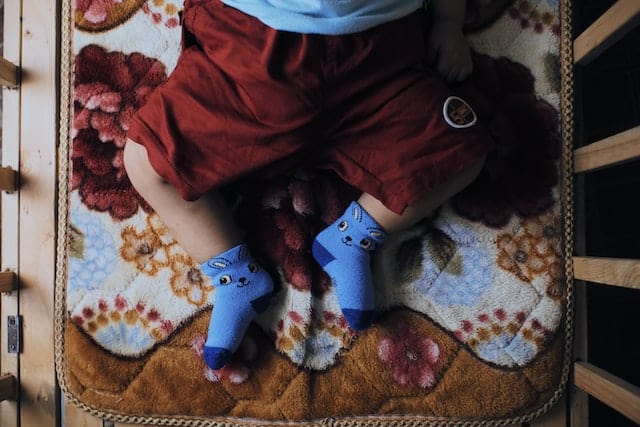It’s not uncommon for parents to catch their toddlers looking between their legs or touching their genitals. While this behavior may seem concerning or even embarrassing, it’s actually a normal part of a child’s development.
Understanding Toddler Behavior is key to recognizing that this behavior is not necessarily a sign of anything abnormal or harmful. Toddlers are curious about their bodies and exploring their genitals is a natural part of that curiosity.
However, it’s important for parents to be aware of Health and Safety Concerns, such as teaching their child to wash their hands before and after touching their genitals and ensuring they’re not doing so in public spaces.
Cultural Perspectives may also play a role in how parents perceive this behavior. In some cultures, exploring one’s genitals is seen as a private matter, while in others it’s considered a normal part of growing up.
Regardless of cultural beliefs, Parental Guidance and Support is crucial in helping children understand appropriate boundaries and behaviors. It’s important to approach this topic in a neutral and educational manner, rather than shaming or punishing the child.
Key Takeaways
- Toddler curiosity about their genitals is a normal part of development
- Parents should be aware of health and safety concerns related to this behavior
- Parental guidance and support is crucial in helping children understand appropriate behaviors and boundaries.
Understanding Toddler Behavior

1. Exploring and Curiosity
Toddlers are known for their natural curiosity and desire to explore the world around them. They are constantly seeking out new experiences and learning opportunities, and this often involves looking between their legs.
While this behavior may seem strange to adults, it is a normal part of toddler development.
When toddlers look between their legs, they are often exploring their bodies and discovering new sensations. They may be fascinated by the way their legs move or the feeling of their clothes against their skin.
This behavior is a natural part of their curiosity and desire to learn about the world around them.
2. Cognition and Brain Development
Toddlers are also developing their cognitive abilities and brain function during this stage of life. Looking between their legs can help them develop spatial awareness and improve their understanding of their body and its movements.
This behavior can also help improve their hand-eye coordination and overall motor skills.
As toddlers continue to explore and learn about their bodies, they are also developing important neural connections in their brains. These connections are essential for future learning and development, and can have a significant impact on a child’s overall cognitive abilities.
3. Baby Yoga and Stretching
Another reason why toddlers may look between their legs is related to baby yoga and stretching. Many parents and caregivers encourage their children to engage in these activities, which can help improve flexibility and overall physical development.
When toddlers stretch and move their bodies, they may naturally look between their legs to see what is happening. This behavior is a normal part of the stretching and movement process, and can help improve a child’s overall physical abilities.
In summary, toddlers looking between their legs is a normal part of their development and exploration. It can help with cognitive and physical development, and is a natural part of their curiosity and desire to learn about the world around them.
Health and Safety Concerns
1. Physical Health
Looking between legs is a common behavior among toddlers that may raise some health and safety concerns. One of the main concerns is the risk of injury. Toddlers may fall or bump into objects while looking between their legs, which can result in bruises, cuts, or even head injuries.
To prevent such accidents, parents should ensure that the toddler is in a safe environment while engaging in this behavior.
Another physical health concern is related to the posture that the toddler assumes while looking between their legs. This posture can put a strain on the neck, back, and leg muscles, which may cause discomfort or pain.
Pediatricians recommend that parents encourage the toddler to change positions frequently and avoid staying in the same posture for too long.
2. Mental Health
While looking between legs is not necessarily a sign of mental health issues, it may indicate some underlying emotional or psychological needs. For example, toddlers may engage in this behavior as a way to cope with stress or anxiety.
In some cases, they may also do it to seek attention or affection from their caregivers.
If the behavior persists or interferes with the toddler’s daily activities, parents should consider consulting a mental health professional. A mental health professional can help identify any underlying issues and provide appropriate interventions to support the toddler’s emotional and psychological well-being.
In conclusion, looking between legs is a common behavior among toddlers that may raise some health and safety concerns. Parents should ensure that the toddler is in a safe environment while engaging in this behavior and encourage them to change positions frequently.
If the behavior persists or interferes with the toddler’s daily activities, parents should consider consulting a pediatrician or mental health professional.
Cultural Perspectives

When it comes to toddlers looking between their legs, cultural perspectives vary widely. Some cultures view this behavior as completely normal, while others believe it to be a sign of something more sinister.
1. Cultural Beliefs
In some cultures, toddlers looking between their legs is seen as a natural part of development. For example, in many African cultures, it is believed that children who look between their legs will have a successful future.
This is because the behavior is associated with curiosity and a desire to learn.
In other cultures, however, the behavior is viewed with suspicion. In some Asian cultures, for example, it is believed that if a toddler looks between their legs, they will become possessed by evil spirits.
Similarly, some Native American cultures believe that if a child looks between their legs, they will become sick or die.
2. Old Wives Tales and Superstitions
In addition to cultural beliefs, there are also many old wives tales and superstitions surrounding toddlers looking between their legs. Some people believe that if a toddler looks between their legs, it means that they are going to have a sibling of the opposite sex.
Others believe that it is a sign of good luck or that it means the child will be particularly intelligent.
There are also many superstitions surrounding what a toddler might see when they look between their legs. Some people believe that if a child sees a spider, it means that they will have good luck. Others believe that if they see a snake, it means that they will be cursed.
Overall, the cultural perspectives on toddlers looking between their legs are varied and complex. While some cultures view the behavior as completely normal, others see it as a sign of something more sinister. Old wives tales and superstitions also play a role in how the behavior is perceived.
Parental Guidance and Support
1. Understanding Body Language
Parents play a crucial role in understanding their child’s body language. Toddlers often communicate through nonverbal cues, and it’s essential for parents to be attentive to these cues.
When a toddler looks between their legs, it may indicate that they are feeling shy or anxious. The child may be attempting to hide or avoid eye contact with someone.
If a toddler is feeling overwhelmed or stressed, they may also look between their legs as a way of seeking comfort.
Body language experts recommend that parents pay close attention to their child’s posture and facial expressions when they look between their legs. If a child appears tense or uncomfortable, parents should approach them calmly and offer reassurance. By doing so, parents can help their child feel safe and secure.
2. Encouraging Safe Exploration
While it’s important for parents to be attentive to their child’s body language, it’s also important to encourage safe exploration. When a toddler looks between their legs, it may indicate that they are curious about their body.
Parents should create a safe and supportive environment where their child can explore their body without feeling ashamed or embarrassed.
Parents can encourage safe exploration by using positive language when discussing body parts. They can also provide their child with age-appropriate books and resources that teach them about their body.
By doing so, parents can help their child develop a healthy and positive attitude towards their body.
In conclusion, parents play a crucial role in supporting their child’s emotional and physical development. By understanding their child’s body language and encouraging safe exploration, parents can help their child develop a healthy and positive attitude towards their body.
Physical Development
1. Muscle Development
As toddlers begin to explore their environment, they rely on their muscles to move around. They use their legs to walk, their arms to reach for objects, and their fingers to grasp things.
Toddlers also develop new muscles as they grow, which allows them to do more complex movements.
During this stage of development, it is important for toddlers to engage in physical activities that challenge their muscles. This can include crawling, climbing, and playing with toys that require them to use their muscles in different ways.
2. Balance and Vestibular System
Toddlers also need to develop their balance and vestibular system, which is responsible for maintaining their sense of balance. This system includes the inner ear, which helps with balance and spatial orientation, and the cerebellum, which coordinates movement and balance.
As toddlers learn to walk, they may stumble or fall, but this is a normal part of the learning process. Over time, they will improve their balance and coordination, which will help them to move more confidently.
To support the development of their balance and vestibular system, toddlers can engage in activities that challenge their sense of balance, such as walking on uneven surfaces or playing on a balance beam. These activities can help improve their coordination and spatial awareness.
Overall, physical development is an important aspect of toddlerhood. By engaging in activities that challenge their muscles and balance, toddlers can develop the skills they need to explore and interact with their environment.
Social and Emotional Development

Sibling Interaction
When toddlers begin to explore their surroundings, they often look between the legs of adults or siblings. This behavior is a normal part of their development and should not be a cause for concern.
Siblings can play an important role in a toddler’s social and emotional development by providing comfort and reassurance during this exploration phase.
If a toddler’s sibling is present, they may react in different ways to the toddler’s behavior. Some siblings may find it amusing and engage with the toddler, while others may feel uncomfortable and try to avoid the situation.
It is important for parents to monitor the interaction between siblings and ensure that the toddler’s behavior is not causing any harm or discomfort to their sibling.
Reaction and Comfort
When a toddler looks between the legs of an adult or sibling, their reaction can vary. Some toddlers may become upset or confused, while others may feel comforted by the experience. It is important for parents to be aware of their toddler’s reaction and provide comfort and reassurance if necessary.
Parents can help their toddler feel more comfortable by explaining that looking between legs is a normal part of exploring their surroundings. They can also redirect their toddler’s attention to other activities or toys if they become upset or uncomfortable.
Overall, it is important for parents to understand that a toddler’s behavior of looking between legs is a normal part of their social and emotional development. Siblings can play an important role in providing comfort and reassurance during this exploration phase.
Parents should monitor the interaction between siblings and provide comfort and reassurance to their toddler if necessary.
Related: Why Does My Baby’s Leg Shake When Stretching
Frequently Asked Questions
Why do toddlers bend over when sitting?
Toddlers often bend over when sitting because it helps them maintain balance and stability. This is especially true when they are learning to sit independently. As their muscles develop and they gain more control over their bodies, they will gradually sit up straighter.
What does it mean when a baby stands on their head?
Babies may stand on their heads as a way to develop their motor skills and explore their environment. It can also be a sign of curiosity and a desire to learn. However, it’s important to make sure they are doing so in a safe and supervised environment.
What are some common yoga poses for toddlers?
Some common yoga poses for toddlers include downward dog, tree pose, and butterfly pose. These poses can help promote flexibility, balance, and coordination.
How can I encourage my toddler to stand on their own?
Encouraging your toddler to stand on their own can be done by providing them with plenty of opportunities to practice. This can include holding onto furniture or other objects for support, as well as engaging in activities that promote balance and coordination.
What are some signs that a toddler is ready for potty training?
Some signs that a toddler may be ready for potty training include showing an interest in the bathroom, being able to communicate their needs, and staying dry for longer periods of time. It’s important to remember that every child develops at their own pace, and there is no set age for when a child should be potty trained.
How can I help my toddler develop strong leg muscles?
Encouraging your toddler to engage in physical activity can help promote the development of strong leg muscles. This can include activities such as walking, running, jumping, and climbing. It’s also important to make sure they are getting enough rest and proper nutrition to support their growth and development.

Iesha is a loving mother of 2 beautiful children. She’s an active parent who enjoys indoor and outdoor adventures with her family. Her mission is to share practical and realistic parenting advice to help the parenting community becoming stronger.
